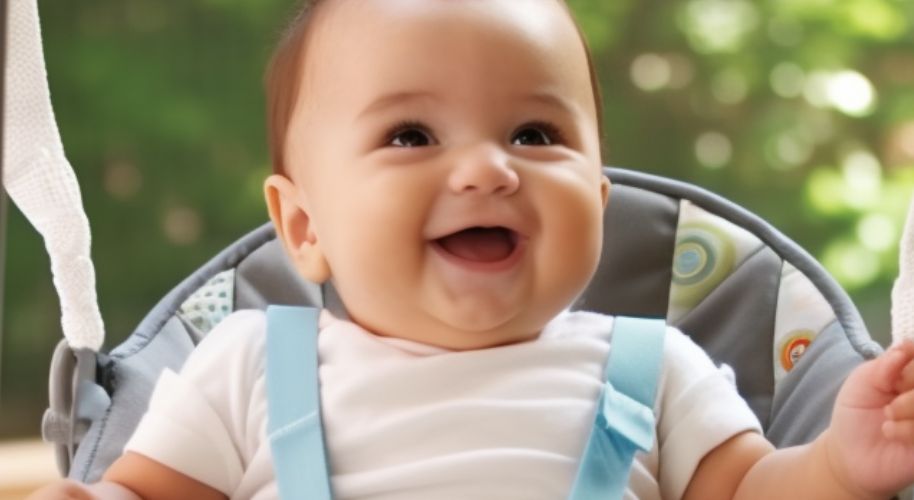Last Updated on June 5, 2025
Choosing the right daycare for your child involves considering many factors, including whether mini-baby swings are allowed.
With their soothing motion, mini baby swings can provide comfort and entertainment for infants, making them a common feature in many homes. Regarding daycare settings, using these swings might be more complex.
Daycares must adhere to strict safety guidelines and regulations, which differ by region and institution. Mini-baby swings can fall into a gray area within these rules. While they can offer undeniable benefits, such as calming a fussy baby or providing a safe place for an infant to rest under supervision, there are also potential risks.
This article aims to explore this topic in-depth, addressing questions about safety, regulations, and best practices.

Is it permissible to have mini baby swings in daycare?
The permissibility of mini baby swings in daycare can vary depending on specific regional and institutional regulations. Certain states, like California, classify baby swings as a form of restraint and thus don’t permit their use in daycares. Similarly, some daycare centers do not allow the use of swings.
Regulations may also stipulate that babies should not sleep anywhere other than cribs, meaning they would need to be moved if a child falls asleep in a swing. Some rules also limit how long children can be confined to swings or similar equipment.
What are the key features to consider when selecting a baby swing?
When selecting a baby swing, there are several key features to consider.
Safety:
This is the most critical feature. The swing should have a sturdy frame that doesn’t tip easily. It should also have a secure harness system – preferably a 5-point harness for maximum safety.
Comfort:
Look for a swing with well-padded seats and multiple recline positions. Some swings also offer newborn head support, which can benefit young babies.
Motion:
Different babies prefer different movements. Some swings offer side-to-side motion, while others offer front-to-back. Some even offer both. Consider a swing with adjustable speed settings to find what your baby likes best.
Portability:
If you plan to move the swing around your home or take it on trips, look for a lightweight, compact model. Some swings can be folded for easy storage and transport.
Power Source:
Baby swings are either battery-operated or plug-in. Battery-operated models offer more flexibility in placement but can require frequent battery changes. Plug-in models can save on batteries but need to be near an outlet.
Entertainment Features:
Many baby swings come with built-in toys, music, or nature sounds. These features can help soothe and entertain your baby.
Ease of Cleaning:
Babies can be messy, so choosing a swing with removable, machine-washable seat covers is essential.
Weight and Age Limits:
Ensure the swing is suitable for your baby’s weight and age. Some swings are designed for newborns and infants, while others can also accommodate toddlers.
You Might also Like These Resources!
- Necessity of Baby Swings: Do You Really Need One?
- Baby Swings and Development: Addressing Concerns
- Ideal Age for Baby Swings: What to Consider
What are the weight and age restrictions for baby swings?

When choosing a baby swing, it’s crucial to keep the weight and age restrictions in mind to ensure your baby’s safety. Here are some key points:
Weight Limits:
Most baby swings can accommodate babies weighing between 6 to 30 pounds. This range can vary depending on the brand and model. For instance, Graco baby swings have an average weight limit between 5 and 35 pounds.
Age Restrictions:
Many brands don’t specify an age maximum because babies develop at different rates. Some suggest that most baby swings have an age limit of six months, but this can depend on the individual child’s development.
Developmental Readiness:
Since there are no specific age limits for baby swings, ensuring your baby is developmentally ready is essential. This means they should have enough neck control to hold their head up independently.
Discontinuation of Use:
Baby swings can typically be used from birth until the specified weight or age limit is reached. Once your baby exceeds these limits, it’s time to stop using the swing to prevent any potential safety risks.
According to the American Academy of Pediatrics, “Infants should always be placed on their back to sleep, never on their stomach or side. This applies to all infants, not just those at risk for SIDS”.it’s crucial to move your baby to a safe sleeping environment like a crib if they fall asleep in the swing.
What is the safe way to utilize a baby swing?
A baby swing can be a great way to soothe and entertain your baby.it’s crucial to use it safely. Here are some guidelines:
Use the Restraint System:
Never leave your baby unsecured in the swing. Always use the harness provided, even if your baby isn’t moving much.
Monitor Baby:
Never leave your baby unattended in the swing. Always keep them within sight and reach.
Limit Swing Time:
The American Academy of Pediatrics advises that babies shouldn’t spend more than 30 minutes in a swing. Too much time can lead to a flat spot on the back of their head.
Safe Sleep Guidelines:
Swings are not a safe place for a baby to sleep. If your baby falls asleep in the swing, move them to a safe sleep surface like a crib or bassinet.
Proper Placement:
Place the swing on a flat, level surface to prevent tipping. Keep it away from stairs, doors, windows, and other hazards.
Regular Checks:
Regularly inspect the swing for wear and tear. Check for loose screws, worn parts, or anything that could pose a safety risk.
Stop Use at Weight Limit:
Stop using the swing when your baby reaches the maximum weight limit specified by the manufacturer.
At what age should a baby no longer use a swing?
Determining when to stop using a baby swing can depend on several factors, including your baby’s age, weight, and development.
Most experts recommend transitioning away from the swing at around six months old. By this age, babies are becoming more aware of their surroundings and may be less soothed by the swing.
Babies around this age start gaining more upper body strength, which allows them to lean forward with their full body weight.
Most babies enjoy swinging until they are about three to five months old. Furthermore, most babies outgrow swings around 9-12 months, but it can vary based on their weight and size.
Once your infant shows signs they want to crawl out (usually around 9 months), you should stop using the baby swing.
Is it safe for my baby to sleep in a swing?
While baby swings can be a helpful tool to soothe a fussy baby, it is unsafe for babies to sleep in a swing. The American Academy of Pediatrics (AAP) recommends against using infant swings for sleep, stating, “Babies should sleep on their backs on firm, flat surfaces.”
According to the Sleep Foundation, sleeping in baby swings has been linked to higher risks of injury and flat spots on the head. Infants haven’t developed muscles enough to hold up their heads, which makes sleeping in a swing potentially risky.
Swings are known to lull babies to sleep, but they aren’t safe for overnight sleep or even napping.
FAQs
What is the recommended duration for my baby to stay in a swing daily?
Most experts recommend limiting your baby’s time in a motorized swing to an hour or less daily. This time should be split into two chunks of no more than 30 minutes each.
On the other hand, some experts advise even shorter durations. You should limit swinging to 15 minutes at a time. Dr. Trachtenberg said, “Babies shouldn’t be in a swing for more than 30 minutes at a time”.
Are swings considered safe for babies with special needs?
Swings, particularly sensory swings, can be beneficial and safe for children with special needs when used appropriately. Sensory swings create a relaxing space and are particularly useful for children with special needs.
Experts also emphasize that special needs swings are powerful adaptive tools that encourage a child’s development, especially regarding sensory integration and therapy use.
Just like with all babies, safety precautions should be taken. Our experts warn against letting babies sleep in swings, as they do not meet safe sleep standards. They advocate for the swing to be used when the baby is awake and under close supervision.
Although swings can be a great tool for babies with special needs, they should be used carefully.
Wrapping up
Baby swings can be a great addition to any daycare if used safely and responsibly. It is important to check your local regulations regarding use in daycare centers and follow safe-sleep guidelines no matter where the swing is used.
Parents should consult their pediatrician before using the baby swing, especially for babies with special needs. With some extra care and awareness, parents can safely use swings to help soothe their infants.
It is also important to remember that regular swings should only be used until the baby reaches the maximum weight limit specified by the manufacturer and not for a baby’s sleep time.
Swings are best used for short periods when the child is awake and should be monitored at all times. Following these guidelines will ensure your baby’s safety.
Together, we can make sure our children are safe and have a secure environment to learn and grow. Thank you for reading!
You Might Also Like These Latest Content!
- Diono Radian 3RXT Installation Guide: Safe Car Seat Setup
- Hanging a Toy Hammock: Organizing Playroom Clutter
- Eliminating Mold from Cloth Diapers: Practical Tips

Amy A. Vincent is a Certified Pediatric Sleep Consultant and a mother of three beautiful children. She helps parents transition their babies from swing sleep to safe, independent sleep. She is passionate about helping parents teach their children the skills needed to become good sleepers and aims to make the process as easy and stress-free as possible. Read more
